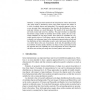Free Online Productivity Tools
i2Speak
i2Symbol
i2OCR
iTex2Img
iWeb2Print
iWeb2Shot
i2Type
iPdf2Split
iPdf2Merge
i2Bopomofo
i2Arabic
i2Style
i2Image
i2PDF
iLatex2Rtf
Sci2ools
DAGM
2005
Springer
2005
Springer
Cluster-Based Point Cloud Analysis for Rapid Scene Interpretation
A histogram-based method for the interpretation of three-dimensional (3D) point clouds is introduced, where point clouds represent the surface of a scene of multiple objects and background. The proposed approach relies on a pose-invariant object representation that describes the distribution of surface point-pair relations as a model histogram. The models of the used objects are previously trained and stored in a database. The paper introduces an algorithm that divides a large number of randomly drawn surface points, into sets of potential candidates for each object model. Then clusters are established in every model-specific point set. Each cluster contains a local subset of points, which is evaluated in six refinement steps. In the refinement steps point-pairs are built and the distribution of their relationships is used to select and merge reliable clusters or to delete them in the case of uncertainty. In the end, the algorithm provides local subsets of surface points, labeled as...
| Added | 26 Jun 2010 |
| Updated | 26 Jun 2010 |
| Type | Conference |
| Year | 2005 |
| Where | DAGM |
| Authors | Eric Wahl, Gerd Hirzinger |
Comments (0)

